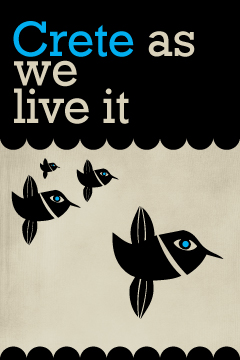A super small hole that barely fits a human body. Yet right on this spot, 1500m high on the eastern slopes of Lefka Ori (White Mountains) and over the region of Melidoni and Atzines, is the entrance of the deepest vertical labyrinth of Greece. Everything is ready for the “dive” to the bottom of Gourgouthakas and the first vertical meters are already crossed. We are already -320 meters below the earth. It is time to admire the underground landscape, adorned with huge stalagmites and stalactites. Gigantic and chaotic spaces are revealed as the flashlight scans the surroundings. The light travels endlessly through the underground beast, a place full of question marks and intersecting arcades that need a lot of time to be explored.
Gourgouthakas was first discovered in 1990 by the Speleological Mission of the Catamaran team, based in Μontbeliard, France. This speleological team reached -452m depth in 1996 and–985m. in 1997. On August 1998 they finally managed to reach the bottom of the chasm, -1.208m. below the surface., where a lovely ‘chiffon’ makes the continuation of the exploration impossible without diving equipment. However, Gourgouthakas is not the only chasm that exists in the same area. There is also the chasm of Liontari (Lion), discovered 15 years ago by the same French team that discovered Gourgouthakas, which also presents great speleological interest. Thus, a few years later, in 2008, the 23 member team managed to overcome all difficulties and reach -1.110m depth (and 2.850m length). This means that the chasm of Liontari is the second deepest in Greece and the 6th in the world. It is worth noting that there are hundreds of thousands of caves all over the world, but only 84 of them (including the one of Liontari) reach a depth of more than -1.000 m.
Gigantic and chaotic spaces are revealed as the flashlight scans the surroundings. The light travels endlessly through the underground beast, full of question marks and intersecting arcades that need a lot of time to be explored.
The sure thing is that the northeastern part of Lefka Ori is one of the most interesting regions in the world for cave explorations and it is expected to attract more speleological missions in the future. It is very likely that systematic research in the region will lead to even more impressive discoveries.
 The break ends, my rope-partner in this mission has already started the descent to the abyss of darkness. Her voice echoes from far away, telling me to follow her even deeper to the ‘guts’ of this stone beast. The temperature is steady at 4 °C but humidity is over 97%, so I wrap myself with a space blanket to keep warm. You cannot wear too many clothes, because you must be able to move freely, and you cannot wear too little because it’s too cold. When you move you sweat and when you stay still you are freezing. So, generally speaking, the conditions in such a deep cave are not exactly ideal and sometimes it feels more like punishment rather than fun! Freezing cold, humidity, mud, hunger, thirst and exhaustion. Sometimes I wonder why am I doing this. I cannot give an answer. We do not need to explain everything anyway, otherwise we would ruin the element of surprise and the pleasure of learning through experience.
The break ends, my rope-partner in this mission has already started the descent to the abyss of darkness. Her voice echoes from far away, telling me to follow her even deeper to the ‘guts’ of this stone beast. The temperature is steady at 4 °C but humidity is over 97%, so I wrap myself with a space blanket to keep warm. You cannot wear too many clothes, because you must be able to move freely, and you cannot wear too little because it’s too cold. When you move you sweat and when you stay still you are freezing. So, generally speaking, the conditions in such a deep cave are not exactly ideal and sometimes it feels more like punishment rather than fun! Freezing cold, humidity, mud, hunger, thirst and exhaustion. Sometimes I wonder why am I doing this. I cannot give an answer. We do not need to explain everything anyway, otherwise we would ruin the element of surprise and the pleasure of learning through experience.
Six hours later we reach a depth of -750m where a basic campsite exists with some tents, set on a flat spot of the cave. Time to rest inside the wet-but-warm sleeping bags. The darkness is the same with our eyes closed or open, and the only sound we hear is the running waters from the high underground waterfalls. We have lost perception of time many hours ago and our minds cannot escape from the tiny hole from which we entered. It feels like a sweet hypnosis, caused by the absolute darkness, the gigantic rocks and the sound of waters that sculpt the limestone on the cliffs for centuries now. Sleep barely touched us, but we had enough energy to go a bit further down to the underground river with the waterfall before we start ascending back to the top. Almost 850 vertical meters separate us from the exit...so, we grab our ropes tightly and start moving towards the surface. At around 5 in the morning we are finally out, after 20 hours below the earth, exhausted but happy that fresh air is finally blowing on our muddy faces.






